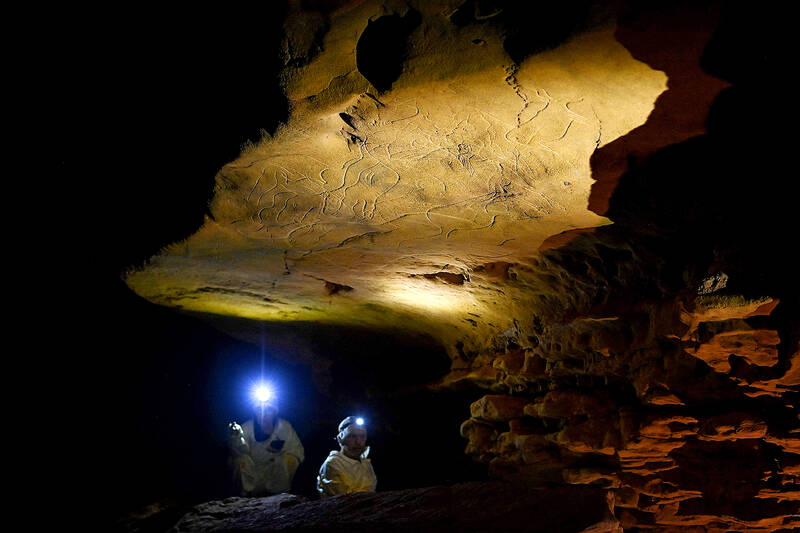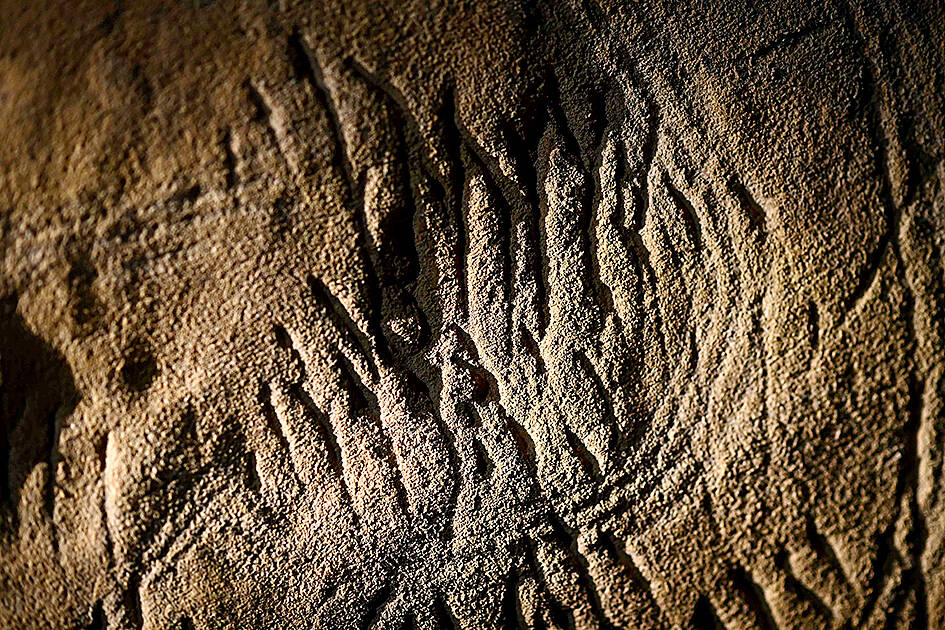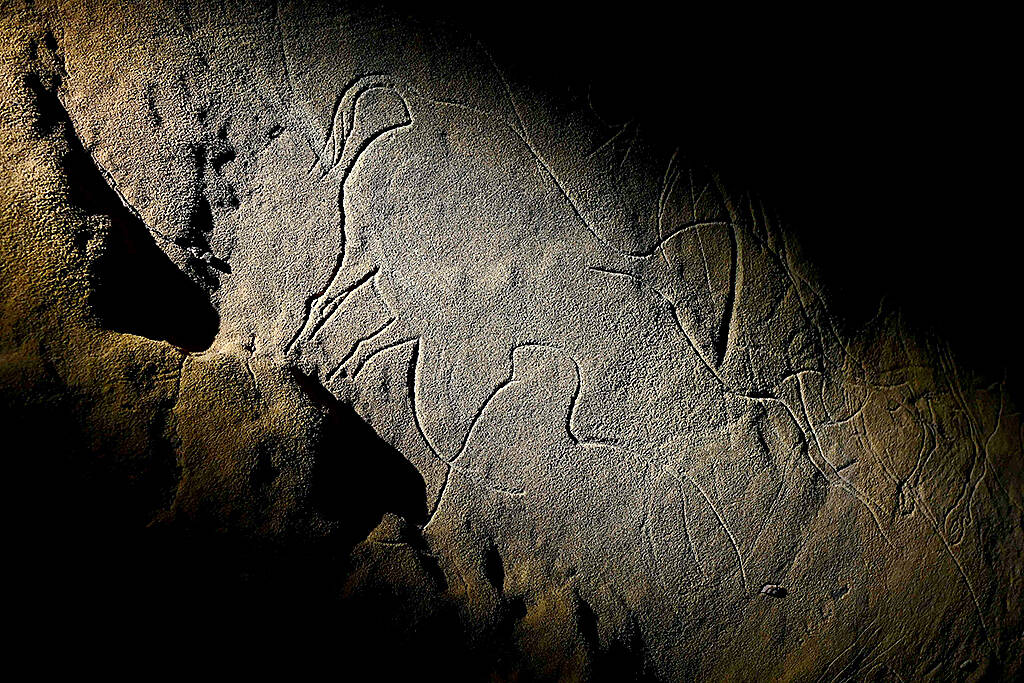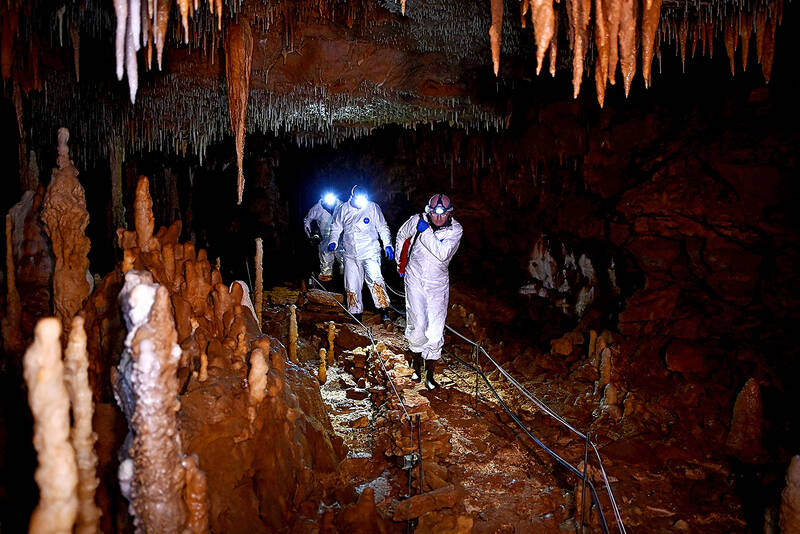Deep inside a labyrinthine cave in southwestern France, ancient humans who lived around 30,000 years ago carved horses, mammoths and rhinoceros into the walls, a fabulous prehistoric menagerie that has rarely been seen — until now.
Discovered in 2000 by an amateur cave explorer, the Grotte de Cussac in the Dordogne department holds ancient human remains, traces of long-extinct bears and stunning, fragile artworks its custodians go to great lengths to preserve.
Typically, the French authorities restrict access to the cave to researchers, who are only allowed to enter it four weeks per year.

Photo: AFP
But a team of journalists was recently allowed to visit the cave for the first time, accompanied by scientists working to unravel its mysteries.
After unlocking the metal grate that blocks the entrance, the group put on white protective overclothes, head coverings and gloves, then disinfected the soles of their boots.
Authorities are anxious to avoid a repeat of the damage done to France’s famed Lascaux caves by microorganisms brought in by visitors.

Photo: AFP
The Lascaux caves — which are also located in Dordogne, though their artworks are estimated to have been created thousands of years after the Cussac carvings — were closed to the public in 1963 to save their precious frescoes.
The Cussac cave is accessed by a narrow passage through boulders that have closed off its inner chambers for thousands of years.
Lighting the way with headlamps, visitors cross vast chambers of stalactites and stalagmites, following the same narrow path as Marc Delluc, the late amateur speleologist who discovered the cave in September 2000.

Photo: AFP
Delluc, who died in 2017, noticed a draft blowing from within the rocks, picked his way through the limestone and uncovered a path of around 100 meters leading to the engravings.
He described the “rush of adrenaline” he felt when he saw the curved figures and silhouettes carved into the rock overhead.
“I realized the privilege I’d been granted, to enter a place that had been consecrated since the dawn of time,” he said.

Photo: AFP
‘SANCTUARY’
The 1.6km-long cave has more than 1,000 carved figures, both animals and stylized feminine forms.
Scientists have dated them to between 26,000 and 35,000 years ago, the time of the ancient Gravettian culture in Europe.
“The Grotte de Cussac is exceptional for its well-preserved state. It was probably closed off very soon after it was occupied, which protected the soil and vestiges inside,” said Emeline Deneuve, chief heritage conservationist for the Nouvelle-Aquitaine region’s cultural affairs department.
Claw marks and signs of burrowing show it was also used by cave bears, prehistoric relatives of the brown bear.
Inside their hibernation chambers, researchers have found the remains of six human bodies, dating to the same period as the engravings.
It is the only known example of a cave used by prehistoric humans for both burials and artworks, said the site’s lead archaeologist, Jacques Jaubert.
The site was a “sanctuary,” not a dwelling, he said. “The group lived outside, in the open or in shelters under the rocks.”
‘FRAGMENTS OF MYTHOLOGY’
Jaubert thinks the cave may have been used for initiation ceremonies, “a rite of passage for adolescents to join the adult world” — a practice often observed in hunter-gatherer groups.
It would also have been seen “as a place of passage between the world of the living and the world of the dead,” he said.
The carvings, which he calls “fragments of mythology,” were made with flint, wood and bone.
They depict bison, ibex, geese and other animals, as well as women, often with giant heads and tiny feet.
“After testing the wall of the cave, leaving traces with his fingers, the artist carved the first animal figures, which were followed by others superimposed over them,” said researcher Valerie Feruglio, who uses 3D imaging to study the artworks, seeking to decipher their stories.
SAFEGUARDING HISTORY
The cave has still not been fully explored.
But authorities are extremely cautious in protecting the site, which was named a historic monument in 2002.
“We are the guardians responsible for preserving and documenting the site,” said Deneuve, the conservation chief.
“We support the research carried out there, as long as it is in line with conservation and heritage requirements. Documenting the cave and digitizing it in 3D is also part of our goal to bring it to the public.”
In October, the Dordogne department opened a free exhibit on the cave in the town of Buisson-de-Cadouin, with reproductions of its artworks.
But authorities say there are no plans to open the cave to the public.

June 23 to June 29 After capturing the walled city of Hsinchu on June 22, 1895, the Japanese hoped to quickly push south and seize control of Taiwan’s entire west coast — but their advance was stalled for more than a month. Not only did local Hakka fighters continue to cause them headaches, resistance forces even attempted to retake the city three times. “We had planned to occupy Anping (Tainan) and Takao (Kaohsiung) as soon as possible, but ever since we took Hsinchu, nearby bandits proclaiming to be ‘righteous people’ (義民) have been destroying train tracks and electrical cables, and gathering in villages

Dr. Y. Tony Yang, Associate Dean of Health Policy and Population Science at George Washington University, argued last week in a piece for the Taipei Times about former president Ma Ying-jeou (馬英九) leading a student delegation to the People’s Republic of China (PRC) that, “The real question is not whether Ma’s visit helps or hurts Taiwan — it is why Taiwan lacks a sophisticated, multi-track approach to one of the most complex geopolitical relationships in the world” (“Ma’s Visit, DPP’s Blind Spot,” June 18, page 8). Yang contends that the Democratic Progressive Party (DPP) has a blind spot: “By treating any

Swooping low over the banks of a Nile River tributary, an aid flight run by retired American military officers released a stream of food-stuffed sacks over a town emptied by fighting in South Sudan, a country wracked by conflict. Last week’s air drop was the latest in a controversial development — private contracting firms led by former US intelligence officers and military veterans delivering aid to some of the world’s deadliest conflict zones, in operations organized with governments that are combatants in the conflicts. The moves are roiling the global aid community, which warns of a more militarized, politicized and profit-seeking trend

The wide-screen spectacle of Formula One gets a gleaming, rip-roaring workout in Joseph Kosinski’s F1, a fine-tuned machine of a movie that, in its most riveting racing scenes, approaches a kind of high-speed splendor. Kosinski, who last endeavored to put moviegoers in the seat of a fighter jet in Top Gun: Maverick, has moved to the open cockpits of Formula One with much the same affection, if not outright need, for speed. A lot of the same team is back. Jerry Bruckheimer produces. Ehren Kruger, a co-writer on Maverick, takes sole credit here. Hans Zimmer, a co-composer previously, supplies the thumping